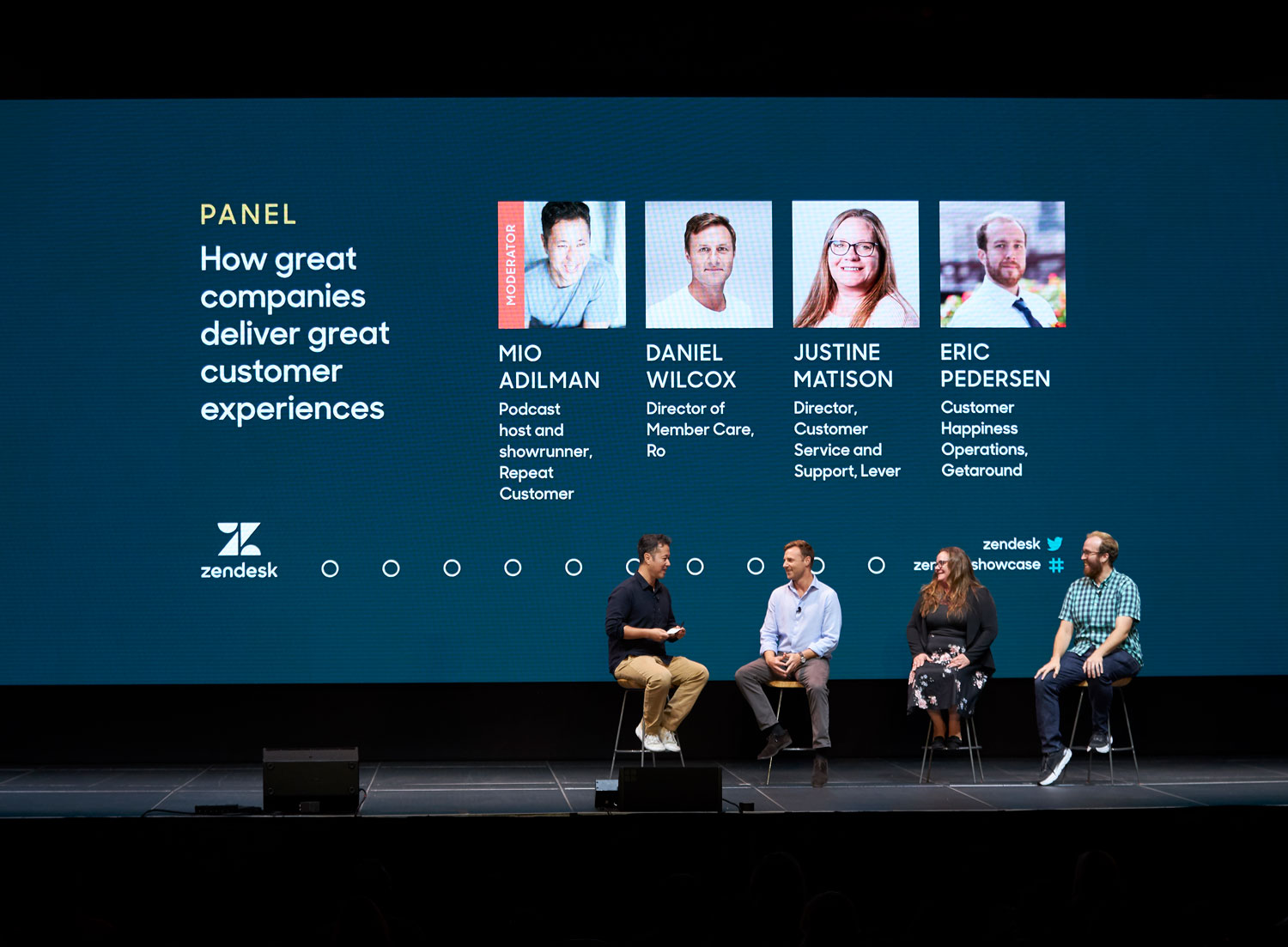One of the things that shocked Mio Adilman when he became host of the Repeat Customer podcast was the great disparity that often exists between legacy companies’ relationship with customers, and those of startups. Adilman knew virtually nothing about customer experience (CX) beyond his own experiences as a customer when he took on the podcast. But he quickly discerned that the key to creating a great customer experience was listening—fostering a kind of intimacy between decision makers and customers. This is a form of customer intimacy that decision makers at large companies are often insulated from by corporate structure. And it’s an intimacy that scaling companies need to preserve as they grow.
At Zendesk Showcase San Francisco, Adilman interviewed Daniel Wilcox, director of care for Ro; Eric Pedersen, senior manager of support operations for Getaround; and Justine Matison, director of customer service and support at Lever, Inc. Here are three key takeaways:
[Related read: 3 lessons from Betterment on building a customer-centric financial service]
1. Trust and customer experience are linked
Ro is a patient-driven healthtech company that connects patients with doctors and treatments. Under the Ro umbrella are three distinct brands: Roman for men, Rory for women, and Zero, a platform that helps people to quit smoking. But it all began with Roman, whose primary clients were men suffering from erectile dysfunction. As Adilman discussed with Wilcox, the medical condition is more serious than many people realize, as it can indicate the presence of other life-threatening diseases. But because men find it embarrassing, they often don’t get it checked out. Ro steps in to solve that problem—and the customer experience leans heavily on the company’s ability to engender trust. Trust, Adilman noted, was key for all three companies.
“We’re talking about healthcare, we’re talking about hiring a workforce, and we’re talking about transportation. These are all very emotional experiences.” Adilman said. “As a customer, if I sit here and think about those three buckets, and I think, ‘Wow, this isn’t some frivolous purchase. Or this isn’t some app that’s going to make me look good on social media. These are core services’…. So, talk to me a bit about where trust comes in and how you approach that when you’re working with your customers.”
Wilcox said he always looks at the company’s site and services with the question in the back of his mind as to whether it looks legit, credible, and safe from a customer standpoint. Steps they’ve taken to support customer confidence include having their phone number boldly displayed, always having a human available to answer the phone, including the credentials of their physicians, and showing their services and pricing plainly.
“Everything is really, really transparent and I think that’s incredibly important,” he said.

But another key is the way they hire. “In our support team, our care team at the moment, we have people who have nursing backgrounds,” Wilcox said. “We have two people right now that are working on their Master’s in public health. As the brand grows, you start to get interest from people who really want to have some impact on healthcare. And it’s much easier [for customers] to have [difficult] conversations with someone who has gone through something themselves or has a family member that has been through something similar, whether that’s ED or another condition. So, in the hiring process it’s really key that we rate people on that they have some connection to our mission. That makes the conversation a lot easier.”
[Related read: How to treat people: advice from volunteer managers and customer service]
2. Communication is (still) key
What Ro does as a matter of customer experience is a big part of the purpose behind Lever, a hiring platform that enables a more seamless experience for companies and job-seeking candidates. Lever connects the talent with hiring managers and other stakeholders all the way through the experience, and the key, Matison explained, is communication, making sure everyone is communicating at every stage of the hire and that the right information is shared.
“In the hiring process it’s really key that we rate people on that they have some connection to our mission.”
Daniel Wilcox
“Recruiting has become a really data-driven process, but many companies don’t really know how to use the data and apply the pieces, so we try and give customers a sense of which data is most important,” she said. This helps ensure that the candidate is the right one for the company and that the employee lands someplace they want to be. And inside Lever, she said, they constantly fill their employment pipeline and use their expertise in conjunction with the data to determine: “Do we want to keep this person warm (ready for a new role); or are they better for another role; or is this one of our rock stars?”
Matison also explained that, as part of implementation, a specialist will begin working with a new customer to understand the goals of the company, to understand the kind of talent a company will need. Making the right match is crucial. A culture mismatch can be really difficult for both the company and the employee. And yet, for companies, it’s not a legitimate reason to let someone go, in many states. Lever has to manage employee communication powerfully to make sure the right messages are shared and understood before making a match.
Making the right match is crucial. A culture mismatch can be really difficult for both the company and the employee.
3. Keep leaders close to the customer experience
Matison said Lever CEO Sara Nahm initially handled most of the customer communications and still stays in touch regularly through meetings with the customer team. Eric Pederson also shared that Getaround’s CEO Sam Zaid initially fielded emails from 9 p.m. to 3 a.m. Even after the company built out its customer care team, the leadership team monitors customer feedback constantly, recognizing that the customer experience needed to be at the core of everything Getaround does.
“Our customers dictate what features the product is going to have, so much of the product—both the app and the whole experience—are directed by customers,” Pederson said. Getaround’s vision is a world in which cars are shared, but sharing a vehicle–often among a person’s most expensive assets—requires that open communication and understanding of the friction points.
“For the car renters, we take a really deep dive into ‘Why do people call us at this time in the trip?’” Every week, he meets with the product department looking for possible iterations to make the rental experience easier. And owners, he explained, are lending their car and need to feel like Getaround is going to take care of them, and it.
Ultimately, any service—especially when there are high stakes, like roadside trouble—requires a bond of trust. The customer experience needs first and foremost to reinforce that trust through communication between customers and leaders, as well as the customer support team. And any company can do that, if they commit to it.
